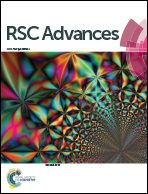A sensitive liquid chromatography-tandem mass spectrometry method for monitoring the caspofungin trough plasma concentration and its association with caspofungin efficacy in intensive-care-unit patients†
Abstract
Caspofungin is a common treatment for fungal infections in intensive care unit (ICU) patients, and in these patients their pharmacokinetics are highly variable. So a rapid and sensitive liquid chromatography-tandem mass spectrometry (LC-MS/MS) method was established for measuring Cmin in 18 ICU patients, and the exposure–response characteristics of caspofungin were investigated. The calibration curve included clinically relevant caspofungin concentrations, ranging from 0.05 to 20 mg L−1. The mean recovery rate ranged from 85.2% to 95.3%, while the intra- and interday precisions were <5.5% and their accuracies were within the range of 96.2–102.3%. The overall Cmin was 2.13 ± 0.99 mg L−1 (mean ± SD; range, 0.51–3.79 mg L−1). Patients were infected by either Candida spp. (n = 13) or Aspergillus spp. (n = 5), and caspofungin therapy was effective in 66.7% (n = 12) of them. 76.9% (10/13) patients (infected by Candida spp. and Cmin > 1 mg L−1) achieved clinical success while 23.1% (3/13) patients (Cmin > 1 mg L−1: n = 1; Cmin < 1 mg L−1: n = 2) failed to show a clinical response. All five patients infected by Aspergillus spp. had a mean plasma Cmin above 0.5 mg L−1, and only two achieved clinical success. Validated LC-MS/MS is a simple, rapid and accurate method that is suitable for monitoring the concentration of caspofungin. Cmin exhibits a wide range in ICU patients, and relatively good treatment results are obtainable when Cmin exceeds the 90% minimal inhibitory concentration (Candida spp: 1 mg L−1; Aspergillus spp: 0.5 mg L−1).


 Please wait while we load your content...
Please wait while we load your content...